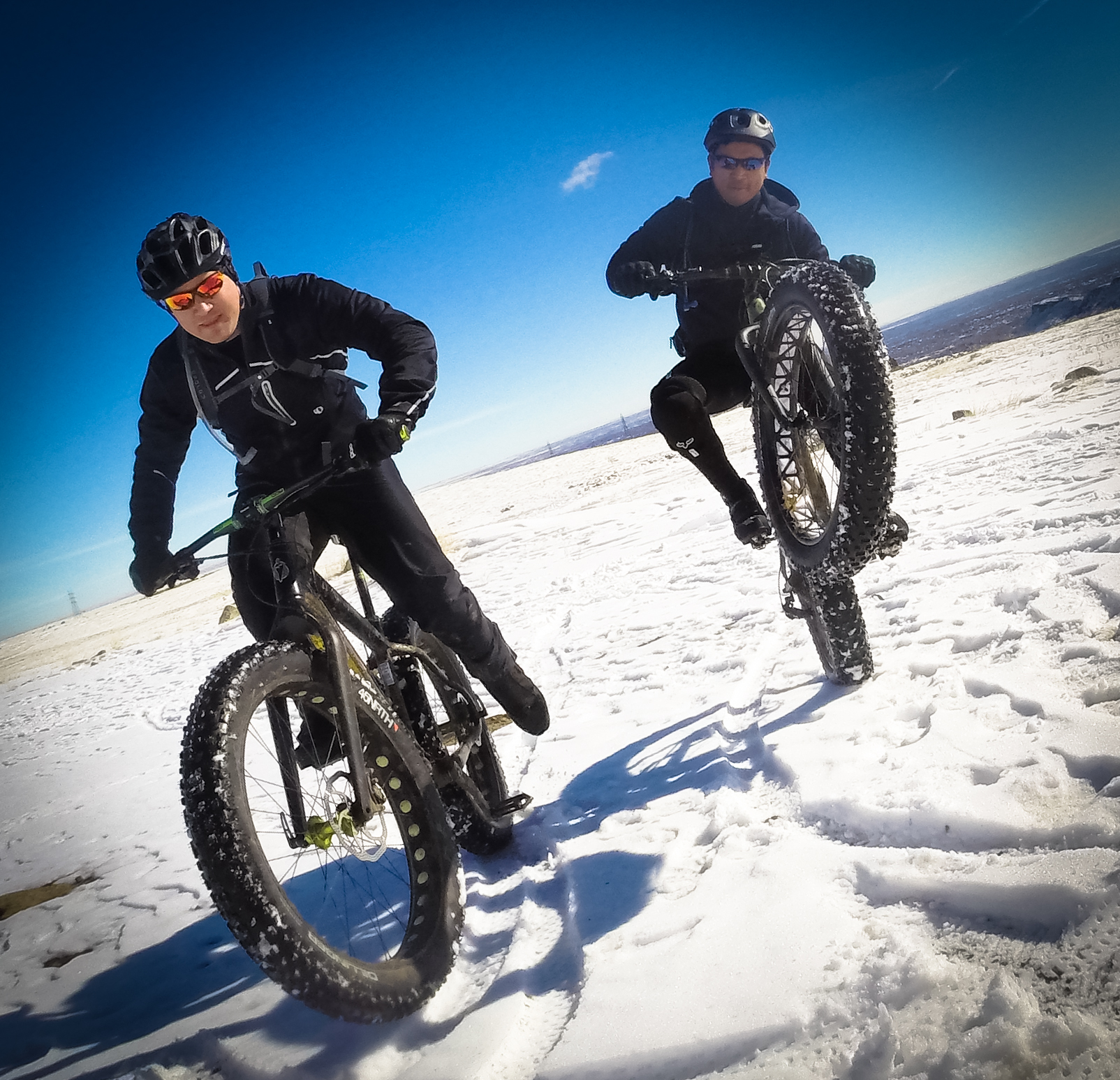
We reported on Terrene’s entry into the fat bike tire market with the Wazia last year, which proved to be an excellent choice as a durable, all-around snow bike tire. More recently, we got a sneak peek at the coming race-inspired fat bike tire: the Cake Eater. This year, I got a chance to put the new rubber to the test.
[see_also id=’223827′]
The Cake Eater comes in standard 26×4.0” and 26×4.6” widths, mid-fat versions for 27.5×2.8″, and even a fat 27.5×4.0″. Terrene says the Cake Eater is “inspired by studless winter vehicle snow tires,” but they do offer a studded version as well. For do-it-yourselfers looking to save a little coin, studs may be purchased separately and installed in the ready-made stud receptacles (a rather tedious process).
For studless rides, the Cake Eater’s knobs have extensive siping for additional grip in snowy conditions. The most discriminating feature of the Cake Eater is the commitment to smaller, smoother center knobs for lower rolling resistance, and more aggressive side knobs for cornering traction, especially in the softer corners. I found this design choice made a definite difference in how the tire performed on exactly the trails the tire is intended for.
My Cake Eaters arrived installed tubeless and ready to roll, so I didn’t have to mount or inflate them. What I can say is that they stayed sealed throughout my test period and I never had to add air. In fact, I did let out air in my search for the optimum pressure for these tires, but only once had to break out the pump, after switching back from snow to hardpack. Never did they need air added as a result of seepage.
For any given condition, I found these tires ran best with about 2psi more pressure than most fat bike tires I’ve tested, probably due to a combination of width (4.6” vs. 4.8”), tread (less aggressive center knobs), and low weight for the width.
4.6″ Cake Eaters weigh anywhere from 1480 to 1700 grams depending on the casing chosen and the presence or absence of studs. Prices range from $120 to $200 for the various models.
First, a Note About Dry Land
Unfortunately for fat bike aficionados, Colorado seems to be in the midst of the warmest, driest winter in known history. That being the case, my first few rides on the Cake Eater were on dry trails, before I had a chance to head into the high country where the snow was more plentiful. As a dry land fat bike tire, the Cake Eater is top notch. The low lying center knobs kept me rolling fast with little effort compared to other fat bike tires, and even my 4.6” demos created very little of the auto-steer endemic to fat biking. Even with the small (by fat bike standards) center knobs, the tires gripped well on hardpack and really delivered confidence in Colorado Springs’s infamously-gravelly singletrack.
The Cake Eaters proved to be far more maneuverable than a typical fat bike tire. The most interesting thing about the Cake Eater was how it ate up even the slightest bit of berm; this is a fat bike tire that encourages the rider to get horizontal… intentionally and in a good way. If a fat bike was my only bike and/or one that got a lot of summer use, I would definitely want a set of Cake Eaters in my garage.
Testing the Cake Eater in the Snow
As much as I came to appreciate the dry land virtues of the Cake Eater, the very tire’s reason for existence is to go fast on the snow.
In short, this tire absolutely excels at its stated purpose. It is indeed fast. Really fast. The low-level center knobs grab a groomed trail with authority but without significant rolling resistance. Then, when it comes time to corner, as the tires lean into the turn the more prominent side knobs engage and promote the kind of confidence necessary to take snowy corners without bleeding momentum. The Cake Eater will allow a little drift, but then the side knobs catch and put you right back on track. Not only is it fast and fun, it’s confidence inspiring. It is indeed the best of both worlds. I can’t imagine wanting any other tire on a prepared snow course.
While the Cake Eater does maximize utility–and fun–in its intended environment, its focus does become somewhat less appealing when stepping outside its natural environment. On a groomed or packed trail, this tire will allow you to pedal up impressive grades with minimal effort. But once there’s a few inches of fresh fluff on the ground, the minimal knobbing in the center lacks the bite for truly powering up soft hills. Up to a few new inches, a very light, controlled touch is necessary, and after a couple more inches, the tire isn’t quite up to the task. The Cake Eater isn’t so much an exploration tire as it is a speed demon. Getting it out on a nice, groomed fat bike trail is winter nirvana, but heading into the unprepared can be a chore, leading to more dismounts than I like.
Word to the wise: if you’re wanting to rip where hardpack may have turned icy, or go gliding across a frozen lake with no packed snow on top, get the studs.
Final Take on the Cake Eater
The Cake Eater is an excellent choice for anybody who is serious about fat bike racing, just wants the joy of going fast on a fat bike, or needs a tire that will continue to be fun when the snow melts. In this sense, the Cake Eater is aptly named: you can have your fat bike, but you can still eat miles at speed as if on a regular bike. But the analogy does have a limit. If you’re looking to break trail on unprepared surfaces, or don’t mind the extra grunt of pushing through new fluff, a meatier tread pattern may be in order.
I applaud the intrepid souls who get satisfaction out of plowing their monster knobs through fresh powder, but I am not one of them. For the type of fat biking that gets me jazzed, it’s the Cake Eater all the way.
Thanks to Terrene for providing the Cake Eater for review.

























1 Comments
Feb 17, 2018